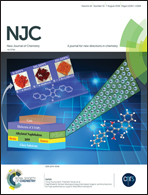P3HT:spiro-OMeTAD blending system as a hole conductor for solid-state hybrid solar cells with a dendritic TiO2/Sb2S3 nanorod composite structure
Abstract
A hybrid solar cell (HSC) based on a solution-processable binary blend of poly(3-hexylthiophene-2,5-diyl) and 2,2′,7,7′-tetrakis-(N,N-di-p-methoxyphenylamine)-9,9′-spirobifluorene (P3HT:spiro-OMeTAD) with a dendritic TiO2/Sb2S3 nanorod composite film was successfully fabricated for the first time. The sparse dendritic TiO2 structure was beneficial for the growth of Sb2S3 nanorods in the adjacent dendritic TiO2 structure. Owing to the well-matched energy levels of TiO2, Sb2S3, P3HT, and spiro-OMeTAD, electrons were effectively separated and transported. The HSC assembled of TiO2/Sb2S3/P3HT:spiro-OMeTAD/Au composite films achieved a highest power conversion efficiency (PCE) of 1.53%, and the corresponding stability was investigated over one month.



 Please wait while we load your content...
Please wait while we load your content...